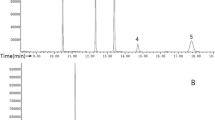Abstract
HPLC was used to obtain fingerprint patterns of organic compounds extracted from roots of five soybean varieties at seven stages of growth. Fifteen major peaks were observed in all varieties at most growth stages. With increasing stage of growth, the less polar compounds accounted for a greater relative percentage of total peak area. Concentration of compounds extracted from roots increased dramatically as plants approached nodulation and flowering and then decreased to initial levels as plants matured.
Similar content being viewed by others
References
Barber, D.A., andMartin, J.K. 1976. The release of organic substances by cereal roots into soil.N. Phytol. 76:69–80.
Bokhari, U.G., Coleman, D.C., andRubink, A. 1979. Chemistry of root exudates and rhizosphere soils of prairie plants.Can. J. Bot. 57:1473–1477.
Carballeira, A. 1980. Phenolic inhibitors onErica australis L. and in associated soil.J. Chem. Ecol. 6:593–596.
Cochran, V.L., Elliott, L.F., andPapendick, R.I. 1979. The production of phytotoxins from surface crop residues.Soil. Sci. Soc. Am. J. 41:903–908.
Einhellig, F.A., andRasmussen, J.A. 1979. Effects of three phenolic acids on chlorophyll content and growth of soybean and grain sorghum seedlings.J. Chem. Ecol. 5:815–824.
Einhellig, F.A., andRasmussen, J.A. 1978. Synergistic inhibitory effects of vanillic and p-hydroxbenzoic acids on radish and grain sorghum.J. Chem. Ecol. 4:425–436.
Eussen, J.H.H., andNiemann, G.J. 1981. Growth inhibiting substances from leaves ofImperata cylindrica (L.) Beauv.Z. Pflanzen Physiol. Bd. 102:263–266.
Fehr, W.R., andCaviness, C.E. 1977. Stages of soybean development. Special Report 80, Agriculture and Home Economics Experiment Station, Iowa State University.
Glass, A.D.M. 1975. The allelopathic potential of phenolic acids associated with the rhizosphere ofPteridium aquilinium.Can. J. Bot. 54:2440–2444.
Guenzi, W.D., McCalla, T.M., andNorstadt, F.A. 1967. Presence and persistence of phytotoxic substances in wheat, oat, corn and sorghum residues.Agron. J. 59:163–165.
Kimber, R.W.L. 1973. Phytotoxicity from plant residues. II. The effect of time of rotting of straw from some grasses and legumes on the growth of wheat seedlings.Plant Soil 38:347–361.
Koeppe, D.E., Southwick, L.M., andBittell, J.E. 1976. The relationship of tissue chlorogenic acid concentrations and leaching of phenolics from sunflowers grown under varying phosphate nutrient conditions.Can. J. Bot. 54:593–599.
Kovacs, M.F., Jr. 1971. Identification of aliphatic and aromatic acids in root and seed exudates of peas, cotton, and barley.Plant Soil 34:441–451.
Kuc, J. 1972. Phytoalexins,Annu. Rev. Phytopathol. 10:207–232.
Lee, T.T. 1980. Transfer RNA-peroxidase interaction.Plant Physiol. 66:1012–1014.
Li, C.Y. 1977. Conversion of p-coumaric acid to caffeic acid and of p-hydroxyphenylacetic acid to 3,4-dihydroxyphenylacetic acid byAInus rubra.Lloydia 40:298–300.
Linder, P.J., Craig, J.C., Jr., Cooper, F.E., andMitchell, J.W. 1957. Movement of 2,3,6-trichlorobenzoic acid from one plant to another through their root systems.Agric. Food Chem. 6:356–357.
Linder, P.J., Mitchell, J.W., andFreeman, G.D. 1963. Persistence and translocation of exogenous regulating compounds that exude from roots.Agric. Food Chem. 12:437–438.
Lodhi, M.A.K. 1978. Allelopathic effects of decaying litter of dominant trees and their associated soil in a lowland forest community.Am. J. Bot. 65:340–344.
Martin, J.K. 1977. Factors influencing the loss of organic carbon from wheat roots.Soil Biol. Biochem. 9:1–7.
Mitchell, J.W., Linder, P.J. andRobinson, M.B. 1961. Mechanism of root exudation of α-methoxyphenylacetic acid in the bean plant.Bot. Gaz. 123:134–137.
Mitchell, J.W., Smale, B.C., andPreston, W.H., Jr. 1959. New plant regulators that exude from roots.Agric. Food Chem. 7:841–843.
Murphy, J.B., andStutte, C.A. 1978. Analysis for substituted benzoic and cinnamic acids using high-pressure liquid chromatography.Anal. Biochem. 86:220–228.
Odunfa, V.S.A. 1979. Free amino acids in the seed and root exudates in relation to the nitrogen requirements of rhizosphere soil fusaria.Plant Soil 52:491–499.
Pareek, R.P., andGaur, A.C. 1973. Organic acids in the rhizosphere ofZeamays andPhaseolus aureus plants.Plant Soil 39:441–444.
Patkick, Z.A. 1971. Phytotoxic substances associated with the decomposition in soil of plant residues.Soil Sci. 111:13–18.
Patrick, Z.A., Toussoun, T.A., andSnyder, W.C. 1963. Phytotoxic substances in arable soils associated with decomposition of plant residues.Phytopathology 53:152–161.
Patrick, Z.A., Toussoun, T.A., Koch, L.W. 1964. Effect of crop residue decomposition products on plant roots.Annu. Rev. Phytopathol. 2:267–292.
Preston, W.H., Jr., Mitchell, J.W., andReeve, W. 1954. Movement of α-methoxyphenylacetic acid from one plant to another through their root systems.Science 119:437–438.
Prikryl, Z., andVancura, V. 1980. Root Exudates of Plants VI. Wheat root exudation as dependent on growth, concentration gradient of exudates and the presence of bacteria.Plant Soil 57:69–83.
Rovira, A.D. 1969. Plant root exudates.Bot. Rev. 35:35–57.
Shindo, H., andKuwatsuka, S. 1975. Behavior of phenolic substances on the decaying process of plants. IV. Adsorption and movement of phenolic acids in soils.Soil Sci. Plant Nutri. 22:23–33.
Shindo, H., Marumoto, T., andHigashi, T. 1979. Behavior of phenolic substances on the decaying process of plants X. Distribution of phenolic acids in soils of greenhouses and fields.Soil Sci. Plant Nutri. 25:591–600.
Slominski, B.A. 1980. Phenolic acids on the meal of developing and stored barley seeds.J. Sci. Food Agric. 31:1007–1010.
Sparling, G.P., Ord, B.G., andVaughan, D. 1981. Changes on microbial biomass and activity on soils amended with phenolic acids.Soil Biol. Biochem. 13:455–460.
Toussoun, T.A., Weinhold, A.R., Linderman, R.G., andPatrick, Z.A. 1968. Nature of phytotoxic substances produced during plant residue decomposition in soil.Phytopathology 58:41–45.
Vancura, V.A., andHanzlikova, A. 1972. IV. Root exudates of plants. Differences in chemical composition of seed and seedling exudates.Plant Soil 36:271–282.
Walter, W.M., Jr., andSchadel, W.E. 1981. Distribution of phenols on “Jewel” sweet potato roots.J. Agric. Food Chem. 29:504–506.
Wang, T.S.C., Yang, T.-K., andChuang, T.-T. 1967. Soil phenolics as plant growth inhibitors.Soil Sci. 103:239–246.
Whitehead, D.C., Dibb, H., andHartley, R.D. 1981. Extradant pH and the release of phenolic compounds from soils, plant roots and leaf litter.Soil. Biol. Biochem. 13:343–348.
Author information
Authors and Affiliations
Rights and permissions
About this article
Cite this article
Granato, T.C., Banwart, W.L., Porter, P.M. et al. Effect of variety and stage of growth on potential allelochemic compounds in soybean roots. J Chem Ecol 9, 1281–1292 (1983). https://doi.org/10.1007/BF00982229
Received:
Revised:
Issue Date:
DOI: https://doi.org/10.1007/BF00982229




